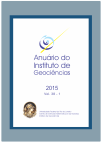Water Quality Assessment in the Córrego Taquara do Reino Hydrographic Basin, Guarulhos Municipality (São Paulo State - Brazil): Effects of Envir onmental Degradation
DOI:
https://doi.org/10.11137/2015_2_137_144Keywords:
São Paulo, Environmental impact, Trophic state indexAbstract
The aim of this research is to assess the water quality in the Córrego Taquara do Reino hydrographic basin, located in the Guarulhos Municipality (São Paulo State -- Brazil). The study area is a segment of approximately 800 m, from the Córrego Taquara do Reino spring to its outfall. Water samples were collected from May 2013 to March 2014 in three different points. The following physical-chemical and microbiological parameters were analyzed in the field and in the laboratory: total phosphorous (Pt), chemical oxygen demand (COD), dissolved oxygen (DO), hydrogen potential (pH), electric conductivity (EC), temperature, turbidity and fecal coliforms (Escherichia coli). The results show a high degree of environmental degradation in the Córrego Taquara do Reino basin, which progresses from an ultra-oligotrophic state in its headwaters, point 1, to a hypereutrophic state in its outfall, point 3, and also in point 2, as a function of the urban occupation in the region. The other results obtained for the physical-chemical parameters such as dissolved oxygen, turbidity and electric conductivity confirm the decrease in water quality in points 2 and 3. Total phosphorous and E. coli values found in points 2 and 3 are above the limit established by the CONAMA 357/05 legislation for a class 3 water body. A linear correlation between electric conductivity and total phosphorous and E. coli is observed, which enables the use of this parameter for a quick evaluation of the water quality in the basin.Downloads
Download data is not yet available.
Downloads
Published
2016-05-10
How to Cite
Vargas, R. R. (2016) “Water Quality Assessment in the Córrego Taquara do Reino Hydrographic Basin, Guarulhos Municipality (São Paulo State - Brazil): Effects of Envir onmental Degradation”, Anuário do Instituto de Geociências. Rio de Janeiro, BR, 38(2), pp. 137–144. doi: 10.11137/2015_2_137_144.
Issue
Section
não definida
License
This journal is licensed under a Creative Commons — Attribution 4.0 International — CC BY 4.0, which permits use, distribution and reproduction in any medium, provided the original work is properly cited.















